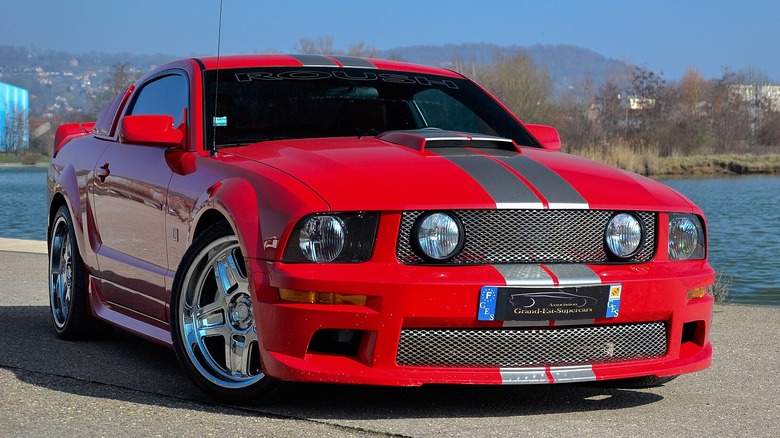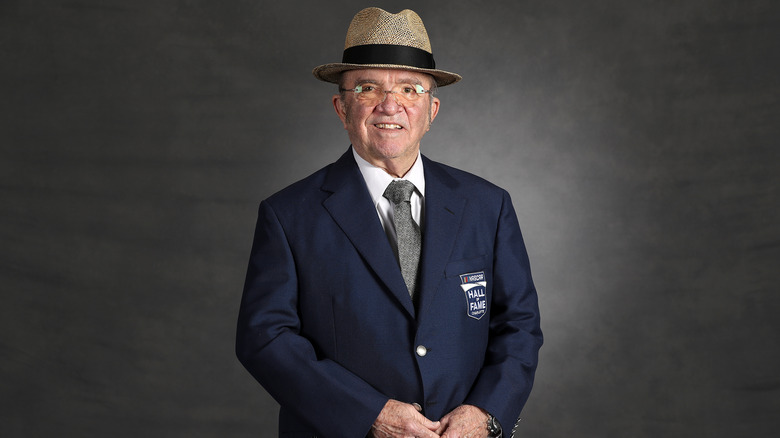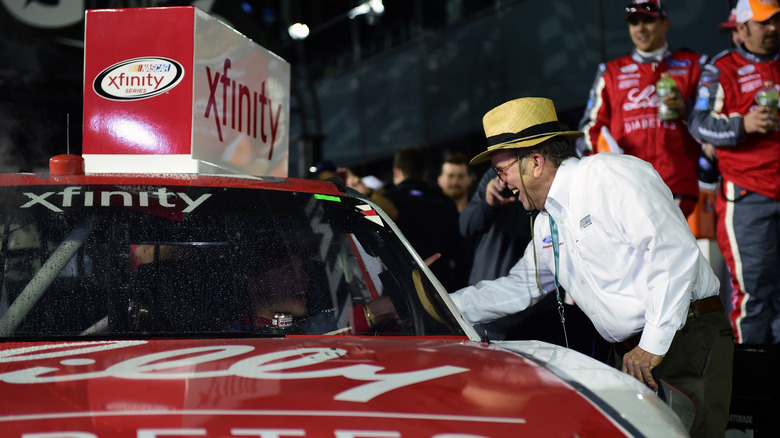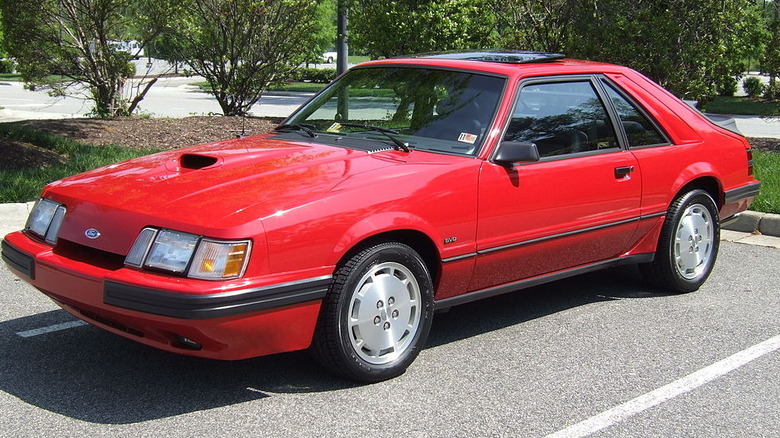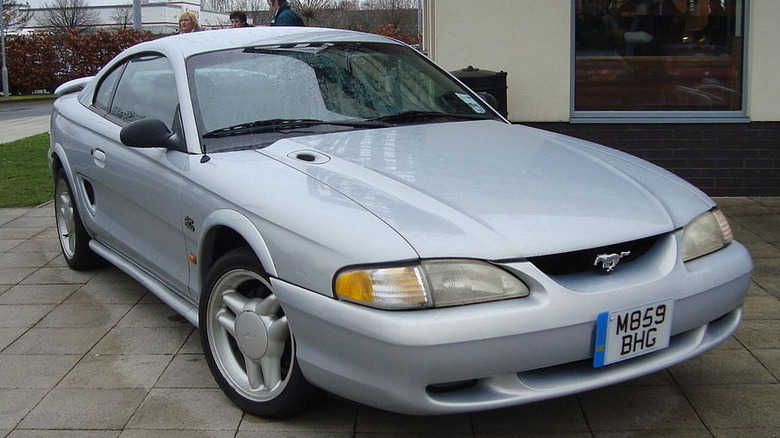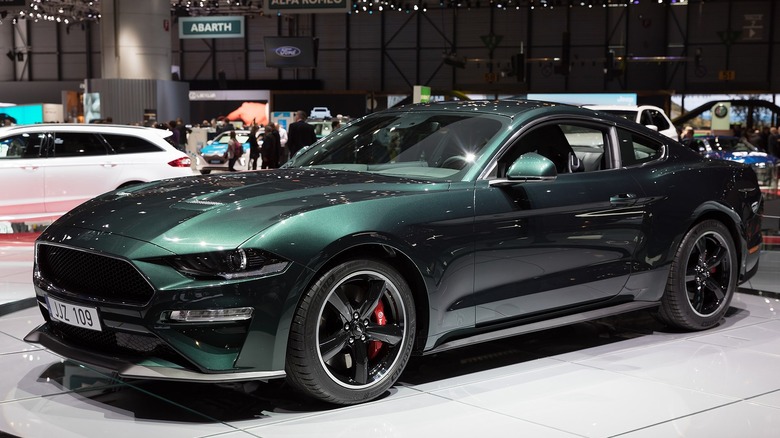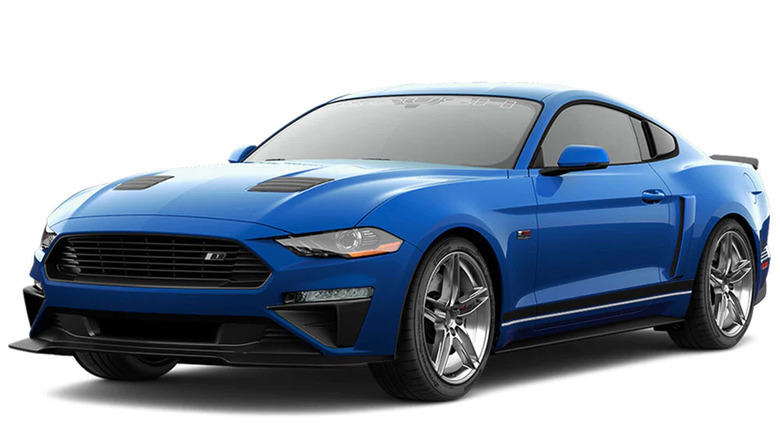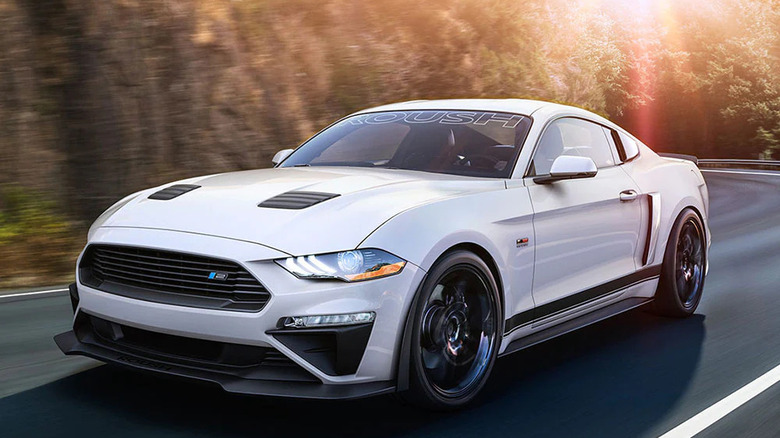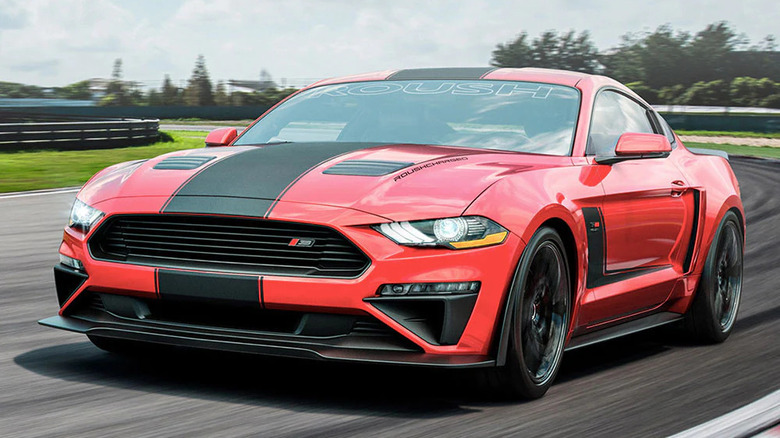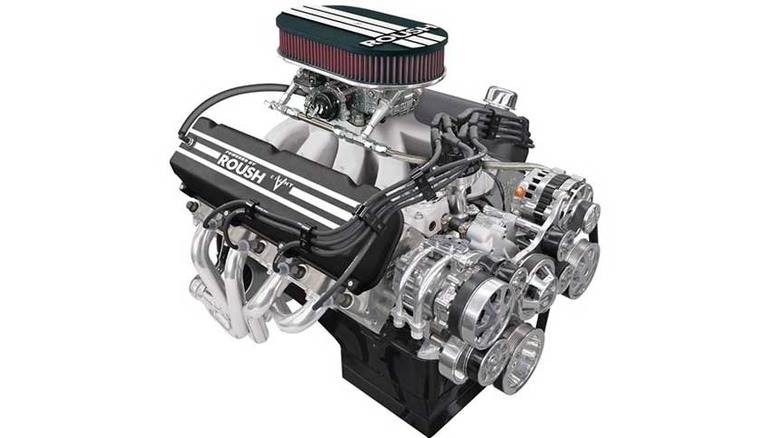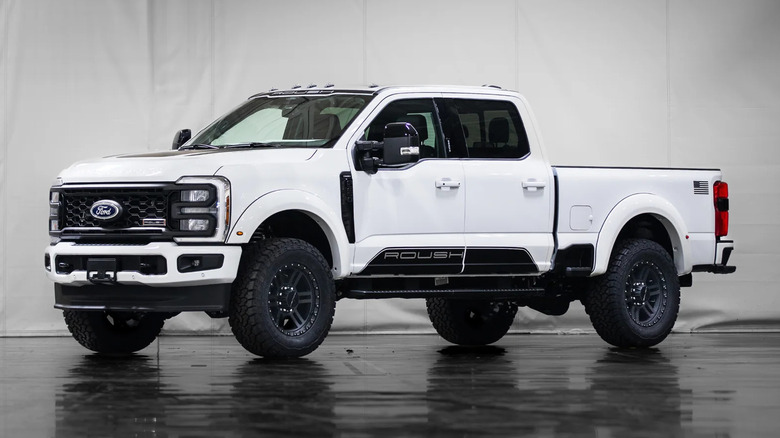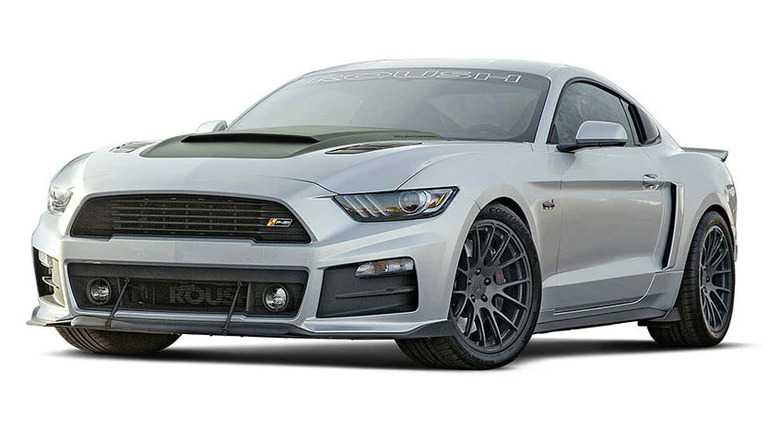Everything Ford Fans Should Know About Roush Mustangs
There are dozens of names enshrined in the pantheon of aftermarket auto tuners. Yenko, Shelby, Abarth, AMG, and others have affixed their badges to some of the most legendary cars ever to grace the pavement. However, Roush is a name that has become synonymous with one of the most popular cars of all time: the Ford Mustang.
The Mustang made its debut in April 1964. It was lightweight and powerful, making an excellent modification platform. Unlike heavier muscle cars, the Mustang was based on an economy car chassis, which kicked off an arms race between car companies. Within a few years, every American manufacturer had a performance car offering meant to compete with the Mustang. Professional and amateur wrench-turners have been modifying one of the world's coolest pony cars for the past sixty years, but perhaps none have as much panache as Roush.
Mustangs with the Roush badge affixed have earned an excellent reputation for power, handling, and styling. Jack Roush, the company's founder and namesake, has a long history with Ford and the engineering pedigree to create some of the most well-regarded Mustangs ever. His name is forever associated with power and performance, and nowhere is this more evident than in his work with the Ford Mustang. Read on to learn everything Ford fans should know about Roush Mustangs.
[Featured image by Alexandre Prévot via Wikimedia Commons | Cropped and scaled | CC BY-SA 2.0]
Jack Roush's pedigree
Who is the man who made it his life's work to push the Mustang to the limit? Jack Roush was born in 1942 — just in time to grow up in the heyday of the pony car revolution. With degrees in physics and scientific mathematics, Roush is not just an automotive legend — he's an engineer whose application of the scientific method to automotive performance has created one of the most legendary names in tuning.
Roush took a position at Ford in 1964, meaning his career and that of the Mustang started in the very same year. He served as an engine development engineer until a penchant for racing led him to split from the company in 1970. Roush soon earned accolades in the racing world, winning multiple championships on the racing circuit between 1970 and 1975. Roush established Roush Performance Engineering in 1976, and for several decades, his passion for engineering and the Ford Mustang has made him one of motorsport's most well-regarded, if not outright legendary, names.
Roush made his bones on the racing circuit
Before you get the idea that Jack Rousch is an egghead with more theory than practical experience, let it be known that he earned his stripes on the racetrack. After departing Ford in 1970 and spending a year at Chrysler, Rousch went racing. Over the rest of his career, Roush would garner championships across many racing series, establishing Roush Performance Engineering in 1976 to supply his parts to the performance aftermarket. His entrepreneurial predilection would come to full bloom in the ensuing decades.
Over the latter quarter of the 20th century, Roush evolved from the drag-racing circuit. Throughout the '80s, Roush's career would continue its skyward trajectory in racing teams that scored manufacturer's championships in 1985 before stepping up to NASCAR in 1988. Since then, his resume grew even more impressive, adding seven NASCAR championships: a pair in the Cup series, four Nationwide championships, and even a laurel in the NASCAR Truck series.
In other words, having a Roush badge or product in your car is not cosmetic — they come backed by decades of excellence in some of the most competitive racing around.
Ford rejected Roush's initial effort
Despite a passion for Mustangs, an excellent reputation, and an impressive heap of racing championships, Ford rejected their former engineer's first iteration of the Roush Mustang.
It was the heyday of the '80s, and America's formerly powerful muscle cars lived in dark days. The Fox body Mustang suffered under governmental regulations, which hamstrung manufacturers with demands that new cars meet specific efficiency and emission standards. The once-powerful performance cars of the '60s and '70s that were still in production may have retained their names, but they were shadows of their former selves.
The Fox-body Mustang was in full swing but left much to be desired. The 5.0L V8 performance option pushed out a respectable but hardly world-beating 225 horsepower, while the gas-sipping four-cylinder managed a paltry 90. Ford's Special Vehicle Operations (SVO) department commissioned Roush to develop the 1988 Mustang into a Corvette killer. Jack delivered a twin-turbo V8 pushing horsepower in the 400 range– nearly twice as much as their then-current performance offering. Ford passed on the car, citing production expenses as unfeasible, but this was just the beginning for the Roush Mustang.
[Featured image by Jim Ramsey via Wikimedia Commons | Cropped and scaled | CC BY-SA 3.0]
Roush Mustangs made their debut with the SN95
In 1995, Roush decided to take matters into his own hands. It was seven years after his factory rejection, and the blocky Fox body had been replaced with the curvaceous SN95 -– the fourth generation of Mustang to hit the streets — the prior year. Unlike the third generation Fox body, which shared its platform with other vehicles, the SN95 was Mustang-specific and represented major improvements over the aging Fox body.
Roush Performance developed a process for modifying factory-built Mustangs to fit Jack Roush's vision. The first generation of Roush Mustangs lasted from 1995 to 1997 and relied on third parties to upgrade the cars. However, this era was short-lived, as by 1997 Roush Performance would begin building the cars in-house. These early Roush Mustangs are sometimes set aside by enthusiasts, but they paved the way for some iconic builds in the coming years.
Meeting with some success, the stage was set for Roush Performance to take what they learned and apply it to the future. One of the characteristics of the early Roush Mustangs was a tiered system that allowed buyers to choose just how far they wanted Roush to push their factory-bought Mustangs.
[Featured image by Kieran White via Wikimedia Commons | Cropped and scaled | CC 2.0]
Rousch categorizes their Mustangs into stages
Not all cars are created equal; that principle also applies to Roush Mustangs. Not every pony car with a Roush badge guarantees a sub-10-second quarter mile, nor does Roush focus on adding horsepower to the detriment of other aspects of car production.
The company offers Mustangs on a tiered basis, with Stage 1 representing the most affordable and least optimized. In contrast, Stage 3 versions have almost every aspect of the driving experience pushed to the limit. The result is something for everyone, including those with emptier wallets who still want to join the Roush owners club.
Though the specifications have changed over the years, the general rule is that the most affordable Stage 1 Mustang receives primarily cosmetic improvements, while the increasingly expensive Stage 2 adds suspension and handling modifications. while the top-tier Stage 3 represents the ultimate in Roush performance by including the benefits of the lower stages in addition to significant enhancements to the power plant.
[Featured image by Matti Blume White via Wikimedia Commons | Cropped and scaled | CC BY-SA 4.0]
Stage 1 Roush Mustang
The first and perhaps most accessible of the Roush upgrades, the Stage 1 Roush Mustang, has taken many forms since its introduction in 1995. The inaugural Stage 1 focused almost entirely on cosmetic upgrades
Fast forward a few decades to 2019, and the Stage 1 offering becomes a tad more sophisticated, though it remains true to the 1995 vision of primarily cosmetic upgrades. The package starts at about $7,000 above the price of the vehicle. Surprisingly, the modern Stage 1 is only available with the EcoBoost four-cylinder engine option, which delivers a respectable 310 horsepower and 350 lb-ft of torque. With the trademark Roush exhaust notes, it also sounds beefier than most four-bangers.
Custom aftermarket components include Roush badging — how else will everyone know it's a Roush? — upgraded wheels, a performance exhaust, spoilers, floor mats, and other little goodies like custom door sill plates and interior upgrades. The horsepower rating remains unchanged, but the styling is distinctive and head-turning.
Stage 2 Roush Mustang
The second and third-stage Roush Mustangs automatically include upgrades to the lower-tier package. In other words, Stage 2 has everything Stage 1 has but adds its own next-level modifications. The original Roush Stage 2 got the Stage 1 and Stage 1 Plus packages in addition to improvements to suspension, including anti-roll bars, front struts and rear shocks, and a complete set of springs. Power add-ons were reserved exclusively for Stage 3.
As the years passed and cars grew more sophisticated, so did Roush's Stage 2 Mustang. The 2020 price point starts at nearly $13,000 above the base car, with further upgrades divided into Signature, Competition, and Podium packages. Like the stages, each upgraded package receives everything the lower package has.
The Signature comes with 20-inch wheels and sport tires, the R9 Aero Body kit, a performance exhaust, an interior package, and a calibrated suspension. The Competition package takes all that and adds locking lug nuts, a Roush Active exhaust, engine bay styling, and a car cover. Committed Stage 2 fans can spring for the Podum package, which takes all of the above and adds Brembo brake upgrades and upgraded powertrain cooling. The upshot is a Mustang boasting 460 horsepower and 420 lb-ft of torque. Not bad, considering there is still another stage to go.
Stage 3 Roush Mustang
Stage 3 is where power comes into play. Aside from getting all the goodies from the first two stages, the original Stage 3 Roush Mustang tacked on an additional 100 horsepower -– not bad, considering the stock V8 barely mustered 240 horsepower. They achieved this with an upgraded induction system, air filter, throttle body, and intake. These relatively basic upgrades may not have been anything to write home about, but they paved the way for future performance.
The 2021 Roush Stage 3 is a certifiable track beast. Most of the performance increase comes from adding a supercharger, and Stage 3 includes the body kits and suspension upgrades of the lower packages. Like Stage 2, Stage 3 offers the Competition and Podium selections, similar to those provided in Stage 2, though the Podium package adds a carbon fiber wing for improved downforce. The Stage 3 Roush Mustang represents the pinnacle of Roush performance, with decades of experience and engineering behind each modification.
The latest iterations are incredibly powerful
Engine technology has come a long way since the inception of the original Roush Mustangs. The last two decades of technological development have significantly boosted horsepower ratings across the market. The EcoBoost shows that manufacturers can coax more power out of engines with small displacements. Extrapolated up to the V8s, this results in power numbers previously unimagined by car enthusiasts.
The modern Stage 3 Roush Mustang is no exception to this rule. Decades of tinkering rooted in Jack Roush's racing success has resulted in a nearly insane 775 horsepower rating from the supercharged Stage 3.
The Roush Stage 3 Mustang is not for the average driver or wallet, as the Stage 3 packages start at $25,000 above the Mustang's base price. Buyers need to purchase the car before they even think about the Roush improvements, and for Stage 3, nothing less than the already premium Mustang GT package will do.
Roush Performance is not just for Mustangs
Despite the Roush name becoming practically synonymous with the Mustang brand, Roush Performance offers packages and upgrades for various vehicles. They tend to stick with Jack Roush's original employer, upgrading other cars in the Ford line, including the Ranger and F-150 pickup trucks. Interestingly, the Polaris Slingshot has also received the Roush treatment.
Not every enthusiast can shell out for the top-tier Roush-built Mustang, but that doesn't mean they're out of the club. Those who do not wish (or are unable) to afford the complete packages can also get Roush performance improvements piecemeal. Roush Performance currently includes aftermarket parts for a more comprehensive array of vehicles. In addition to the pickup trucks, parts are also available for the Ford Raptor, Focus, and Bronco.
Jack Roush cut his teeth developing aftermarket parts, after all, and they offer many cosmetic and performance parts for garage tinkerers and professional mechanics alike. From gas caps and coil covers to supercharger kits, Roush has something for everyone.
Roush paid tribute to the Mustang's namesake with a P51-inspired ride
Jack Roush may be the quintessential car enthusiast's engineer, but that doesn't mean he lacks artistic vision. Over the years, Roush Performance has developed themed and commemorative Mustangs, such as the Jackhammer and the 727 horsepower P-51 Mustang car.
Jack Roush has a particular affinity for aviation, so much so that in 2018, the EAA Warbirds of America added to his accolades by inducting him into their Hall of Fame. In addition to his auto activities, he has personally restored his own P-51 Mustang fighter plane, which also happens to be the namesake of the original Ford Mustang.
With a supercharged 5.0L Coyote V8 and extensive upgrades to brakes and suspension, Roush's homage shares the muscular profile, silver finish, and peak performance of the plane that commanded the skies over Europe in the latter stages of World War II. Roush developed the P-51 Mustang in a limited run -– only 51 were ever built.
